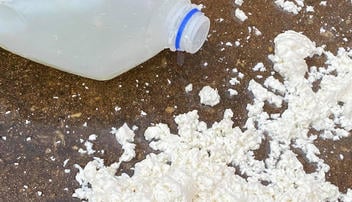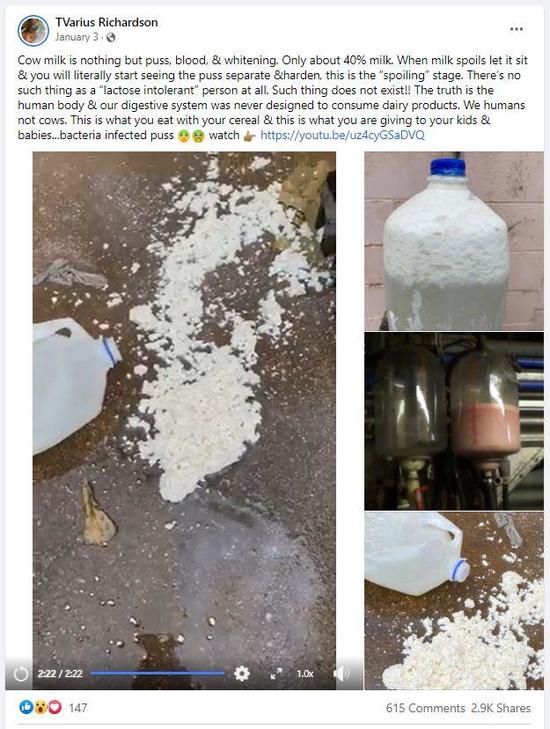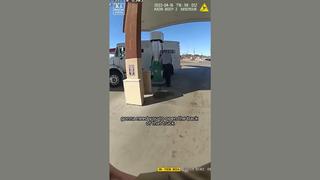
Is cow's milk composed of 60% pus, blood and added whitening to mask the color of the blood? Are the separated white chunks sometimes seen in spoiled milk evidence that milk is full of pus? No, that's not true: When milk spoils, acids produced by bacteria can cause it to curdle. A video showing blood-tainted milk in a glass receiver vessel would not be for human consumption as the dairy farmer who made the video stated several times.
Claims about pus in milk have been circulating in various forms for years. The image of the blood-tainted milk in this post came from a video posted on YouTube by a dairyman in 2013.
This Facebook post (archived here) published by TVarius Richardson on January 3, 2021, was captioned:
Cow milk is nothing but puss, blood, & whitening. Only about 40% milk. When milk spoils let it sit & you will literally start seeing the puss separate &harden, this is the "spoiling" stage. There's no such thing as a "lactose intolerant" person at all. Such thing does not exist!! The truth is the human body & our digestive system was never designed to consume dairy products. We humans not cows. This is what you eat with your cereal & this is what you are giving to your kids & babies...bacteria infected puss🤮 watch 👉🏾 https://youtu.be/uz4cyGSaDVQ
This is what the post looked like on Facebook at the time of writing:
(Source: Facebook screenshot taken on Wed Nov 10 23:22:14 2021 UTC)
This fact check is focused only on the claim that milk contains 60% blood and pus and a whitener, not the questions of whether humans should consume the milk of other species or lactose intolerance.
Richardson's post contains a link to a December 19, 2013, YouTube video titled, "blood in cows colostrum milk" posted on the channel of a vlogging dairyman from Gloucestershire, England, "The Funky Farmer." The image in the post showing the bloody pink milk in the glass vessel is a screengrab taken from this video. The farmer describes how he takes care of some of his cows who have recently calved. He points out several ways these cows and their milk stay separated from the main milking herd.
Despite this being the theme of the video, this screengrab image of the bloody milk is used by anti-dairy activists or trolls to misrepresent milk at the market as if it is full of blood and that whiteners are added to all milk to hide the pink color. On October 23, 2018, Factcheck.afp.com published an article addressing false claims about this photo titled, "No, this is not milk fit for human consumption."
In the video the dairyman explains how these "fresh calvers" are housed separately because they are producing colostrum -- and that's not something he could sell anyway. He has marked the cow's tail with colored tape as an added reminder to milk that cow separately. At the 1:30 mark in the video the interior of the milking parlor can be seen and several glass receiver vessels are visible as the cows are milked. The farmer has already explained that this cow has some bleeding from little capillaries as this was her first calf. He says this doesn't happen often and will fix itself in about a week.
The pink blood-tinged milk is easy to see in the glass vessel in contrast to the white milk in the adjacent vessels. The glass allows a farmer to visually inspect the milk. The vessels are marked as well, to measure the volume of each individual cow's milk before it's added to the large holding tank called a bulk tank. From start to finish in this video, the farmer explains how milk from these "fresh calvers" is not fit for human consumption and the steps he is taking to keep the milk separated from the rest.
Richardson's post contains a video and two other photos featuring a plastic milk jug that is full of curdled milk and whey. This milk seems to have curdled due to spoilage. The jug's cap seal cracks as it is opened in the video. The man narrating says:
This is pus. This is pus, man. Look. This is what you are all drinking, this is what you are feeding your kids, this is what you are giving your all babies. Pus, look. It don't even move. It don't even move, man, look. ... This is pus, see that? So milk, cow milk ain't nothing but blood and pus. You know what I'm saying? They filter it and they add the whitening to it to change it to white. As you can see when milk spoils, it separates from the water, and this is what you all are drinking. This is what you are eating your cereal with, this is what you are giving your babies. This is why people get lactose intolerant. Cow milk was never made for humans. Our intestines and our body was never designed to consume cow milk. We are not cows.
There are several reasons why milk curdles: Spoilage is one of them. Fresh milk can be made to curdle with acidic ingredients or the addition of heat. When milk is acidified the proteins and fat in the milk clump together forming curds. Intentionally adding an acidic ingredient can be the first step in producing a number of dairy products like yogurt, cheese and buttermilk.
The science behind "Why does milk curdle" is explained in this scienceofcooking.com article:
In cookery, curdling is the breaking of an emulsion or colloid into large parts of different composition through the physico-chemical processes of flocculation, creaming, and coalescence. Curdling is intentional and desirable in making cheese and tofu; unintentional and undesirable in making sauces and custards. Curdling occurs naturally in milk if the milk is not used by the expiration date, or if the milk stays out in warm temperature.
Curdled milk is not made of or caused by pus. Pus, which may be present at the site of an infection, is mostly composed of dead white blood cells, bacteria and dead tissue. Milk, produced in the mammary glands of female mammals, is mostly composed of water, fats and proteins. If the mammary gland becomes infected, its milk could contain some pus until the infection is healed. The cow still needs to be milked regardless, but this milk would not be added to the bulk tank.
The dairy industry measures somatic cells in milk as an indicator of the health of a specific cow, or even the specific quarters of her udder. A certain level of somatic cells in the milk is normal, but if the somatic cell count (SCC) goes beyond a certain point it indicates the cow may have an infection. This measurement can apply to an entire herd, which is the bulk tank somatic cell count (BTSCC).
The U.S. Department of Agriculture published an info sheet in June 2021 reviewing U.S. milk quality based on the BTSCC data up to 2019. The allowable limit for Grade A milk in the United States is 750,000 somatic cells per milliliter. Several states have a lower threshold than the national limit. In 2019 the average BTSCC in the U.S. was 171,000 cells/ml, far below the U.S. allowable threshold. Australia, New Zealand, Canada and the European Union have a maximum limit of 400,000.
Milk is not white because of a whitening additive. Lead Stories reached out to Brooke Williams, the director of communications of American Dairy Association Indiana Inc., to find out if there were regulations about this. She pointed us, via telephone on November 11, 2021, to section C2 on page four of the recommended requirements in the USDA regulations for "Milk for Manufacturing Purposes and its Production and Processing," which states that any abnormal condition of raw milk, in appearance or odor, makes it unacceptable for manufacturing purposes.
Dairy Australia explains that no artificial colors are added to make milk white; it is the scattering of light that makes milk appear white:
Caseins are one of the main types of protein in milk which cluster together with calcium and phosphate to form tiny particles called micelles. When light hits these casein micelles it causes the light to refract and scatter resulting in milk appearing white.

















